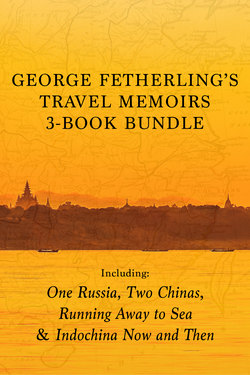Читать книгу George Fetherling's Travel Memoirs 3-Book Bundle - George Fetherling - Страница 21
На сайте Литреса книга снята с продажи.
— THE TARGET ZONE —
ОглавлениеKhan, our local expert, was born and reared in Luang Prabang, the old royal capital on the winding Mekong, the place where we would be heading in a couple of days. When he was a boy, his father wished him to learn French. Apparently the father was older than the norm when Khan was born in 1976 and so was harking back to his own youth when French was a requirement for an ambitious young Lao who wished to get ahead in the established order. Khan studied for only a couple of months. “I was not liked by French,” he remembered. “Everything was le, la, les …” He finished the sentence with a Gallic shrug, brushed hair from his eyes, and took a drag on his cigarette, readjusting the minuscule waist of his grey pleated trousers. His family then countered that he take up Russian, for Russian was still somewhat in fashion, though he found that language, too, to be uncongenial. But he knew he had a knack for English, which is to say a knack for making money. He knew what he was taking us to see, but I wondered how much he knew about why foreigners, particularly ones of a certain age, were interested in going there.
Much later, back home in Canada, I came upon the following item in the Globe and Mail, paraphrasing a news story that had appeared in the paper fifty years earlier, on August 24, 1959: “The Globe and Mail reported that pro-communist Pathet Lao insurgents attacked and infiltrated parts of Vientiane province, within 50 miles of the Laotian administrative capital city of Vientiane. Although unconfirmed by Laotian defence officials, Western military sources said the insurgents attacked two army posts within a 70-mile radius.” And thereby, at least by suggestion, hangs the entire tale.
Assimilating (a polite term) a place as wild as Laos wasn’t an easy task for the French or an inexpensive one. It was in 1907 — the year of so many of the postcards in this book, long after Cambodia and the parts that now make up Vietnam were somewhat stable and at least temporarily safe — that the French got control of all the Lao land on the east side of the Mekong, facing Siam. The Japanese kicked them out during the Second World War, but they returned in 1945 in a massive airborne operation and re-declared the Protectorate. When the local population did not respond by lining the streets waving Tricolours on little sticks, the French granted them status as an independent associated state and then, in a surprisingly short time, full sovereignty. But this resulted in a coalition government that the United States brought down, only to be left with the fear that the Pathet Lao communists would win a majority in the election to be held in 1960 — which, therefore, the CIA shamelessly rigged. In that simpler time and smaller world, the CIA station in Vientiane was one of the agency’s largest, though it had only three hundred agents (the same number as Miami’s). They were under the command of Lawrence R. Devlin, who had just arrived there from Congo where as chief of station he was concerned — innocently so, he professed — in the assassination of Patrice Lumumba, the deposed prime minister.
Of course this was several years after France lost its hold on Indochina as a result of the battle of Dien Bien Phu. The United States had now taken upon itself the ridiculous responsibility for interfering in Southeast Asian affairs. Assuming office in 1961, the new chief executive, John F. Kennedy, made a display of saying that he would invade Laos if necessary. At that point, a curious moment in history seemed to come about. Would the United States attack Vietnam, where communists held power in the north, or Laos, where they were merely, in the American view, waiting in the wings? I have no doubt that Vegas bookmakers were giving odds. In his autobiography, Peter C. Newman, the famous Canadian journalist, remembers being asked to choose between reporting from Vietnam or reporting from Laos, as his editor in Toronto wouldn’t pay for both. Newman made the wrong choice: Laos. Arriving there, he was surprised to discover that Laos, which is landlocked, had a Royal Laotian Navy. A thirty-foot gunboat launched in 1904 was the only fully operational warship. A number of the others, made of rotting wood, were hauled up on the banks of the Mekong for use as chicken coops.
That Kennedy decided to terrorize Vietnam instead (though the great build-up took place under his successors) enraged the military and intelligence establishment who feared that he would wimp out on both alternatives. There is a memorable scene in the Oliver Stone film JFK that depicts a meeting of such hawks. One of them says angrily, “He fucked us in Laos, and now he’s going to fuck us in goddamn Vietnam!” But it was in 1964, the year after Kennedy’s assassination, when the U.S. bombings began. Before they were over, 2 million tons of explosives had been dropped on a small area that the U.S. believed was the marshalling yard of the amorphous Ho Chi Minh trail, which the communists used to help resupply their troops in the field. The weight of the bombs dropped on Laos and Cambodia by the U.S. was greater than that of all those dropped on Europe during the entire Second World War, according even to Robert S. McNamara, the American defense secretary in the Kennedy and Johnson administrations.
